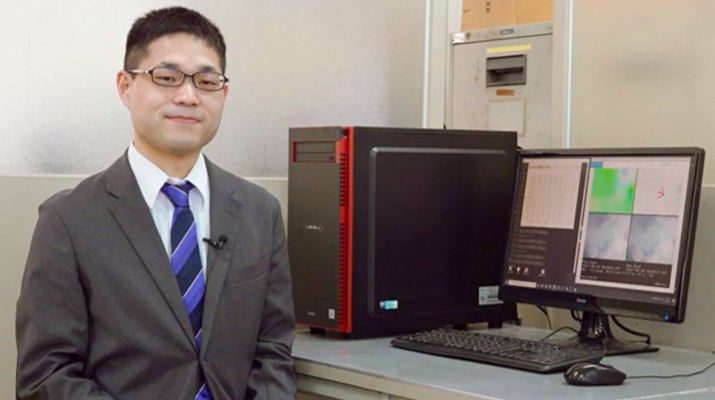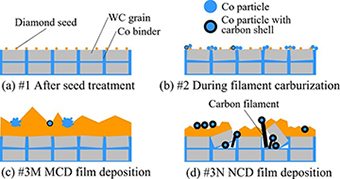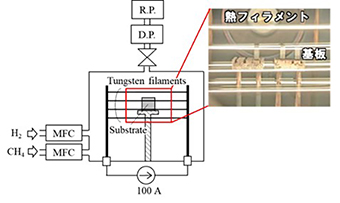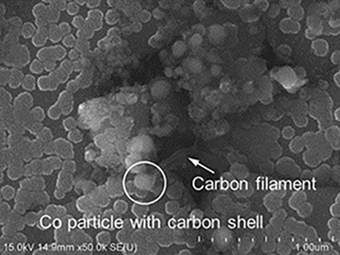
ここからコンテンツです。

Understanding the mechanism of non-uniform formation of diamond film on tools
Paving the way to a dry process with less environmental impact Takahiro Bando
Tools coated with diamond film (diamond-coated tools) are used for difficult-to-machine materials such as CFRP. In the manufacture of diamond-coated tools, a pretreatment is required to remove cobalt from the tool using a liquid in order to achieve a uniform diamond film surface. However, there are concerns about the environmental impact of liquid waste from liquid pretreatment (wet processing), and there is a need to develop a process that does not use liquids (dry processing). A research team led by master’s student Yoshinori Saiki, Assistant Professor Takahiro Bando, Lecturer Toru Harigai and Professor Hirofumi Takikawa from the Department of Electrical and Electronic Information Engineering at Toyohashi University of Technology, has revealed the mechanism by which cobalt makes the diamond film surface non-uniform with the aim of developing a pretreatment that does not require wet processing. In particular, the team found that carbon filaments cause non-uniform formation in smooth, low-friction nanocrystalline diamond films, and that inhibition of carbon filaments is key. This study was conducted in collaboration with OSG Corporation (a leading company in the Higashimikawa region) and Nagaoka University of Technology (which has strong ties with our university), making it a unique research project for Toyohashi University of Technology.

Tools coated with diamond film (diamond-coated tools) are used for difficult-to-machine materials. A typical example of difficult-to-machine materials is carbon fiber-reinforced plastic (CFRP), which is used as a light and hard material to reduce the weight of aircraft and automobile bodies.

Tungsten carbide with cobalt as a bonding agent is usually used as a tool for diamond film deposition. Hot filament chemical vapor deposition (HF-CVD) is used as the film deposition technique. The following figure shows the film deposition process. When diamond film is deposited on cemented tungsten carbide by HF-CVD, it is known that the quality of diamond-coated tools deteriorates as the diamond film becomes non-uniform due to cobalt grains. Therefore, a liquid pretreatment is required to remove the cobalt on the cemented tungsten carbide. However, there are concerns about the environmental impact of liquid waste from this treatment (wet processing), so there is a need to develop a process that does not use liquids (dry processing). Our research team initially revealed the mechanism by which cobalt makes the diamond film surface non-uniform with the aim of developing a pretreatment that does not require wet processing. There are two types of diamond films deposited on tools: microcrystalline diamonds and nanocrystalline diamonds. Previous research has proposed a mechanism for non-uniform formation only for microcrystalline diamonds. However, there were no findings about nanocrystalline diamonds, which are considered to be smooth, less frictional, and be more suitable for tools. Secondary, the research team revealed the non-uniform formation mechanism for nanocrystalline diamonds as well as microcrystalline diamonds with time-resolved observation of the deposition process for each. In particular, we found that in nanodiamond, the non-uniform formation is caused by carbon filaments lifting particles on the carbide substrate and making the substrate non-uniform.

The research team also showed that it is important to inhibit carbon filament growth in the initial stage of deposition in order to inhibit the non-uniform formation of nanocrystalline diamond films in dry processing. In future, we plan to develop a deposition technique using HF-CVD in a high-temperature environment that can inhibit the growth of carbon filaments. Furthermore, after establishing a uniform formation process for nanocrystalline diamond films, we plan to apply the process to actual tools and investigate their machining performance.
Reference
Yoshinori Saiki, Takahiro Bando, Toru Harigai, Hirofumi Takikawa, Takahiro Hattori, Hiroaki Sugita, Natsue Kawahara, and Kunihiko Tanaka. Sequential morphology of cobalt from cemented tungsten carbide in microcrystalline and nanocrystalline diamond films by HF-CVD. Diamond and Related Materials 132, 109643 (2023), https://doi.org/10.1016/j.diamond.2022.109643
工具上ダイヤモンド膜の不均一形成メカニズムを解明
環境負荷の少ないドライプロセスへの道を開拓坂東 隆宏
ダイヤモンド膜をコーティングした工具(ダイヤモンドコート工具)は、CFRPといった難削材向けの工具として利用されています。ダイヤモンドコート工具の作製においては、ダイヤモンド膜表面を均一とするため、工具上のコバルトを液体により除去する前処理が必要になります。一方で、液体による前処理(ウェットプロセス)では廃液による環境負荷が懸念され、液体を用いない処理(ドライプロセス)の開発が求められています。豊橋技術科学大学 大学院博士前期課程 税木善則、電気・電子情報工学系 坂東隆宏助教、針谷達講師、滝川浩史教授らの研究チームは、ウェットプロセスを必要としない前処理開発に向け、まずは、コバルトがダイヤモンド膜表面を不均一にするメカニズムを明らかにしました。特に、滑らかで摩擦が小さいナノダイヤモンド膜においては、カーボンフィラメントにより不均一形成が引き起こされていることを明らかにし、カーボンフィラメント抑制が鍵となることを明らかにしました。また、本研究は、東三河を代表する企業であるオーエスジー株式会社及び本学と強い結びつきのある長岡技術科学大学との共同研究により実施し、豊橋技術科学大学としての特色ある研究となりました。
ダイヤモンド膜をコーティングした工具(ダイヤモンドコート工具)は、難削材向けの工具として利用されています。難削材の代表例は炭素繊維複合材料(CFRP)であり、軽くて硬い材料として、航空機や自動車の車体の軽量化といった目的に利用されています。
ダイヤモンド膜を成膜する工具としては、通常、コバルトを結合剤として用いた超硬が用いられます。成膜手法としては、熱フィラメントを用いた化学気相成長法(HF-CVD)が用いられます。前述の図に成膜時の様子を示しています。HF-CVDにより超硬上へダイヤモンド膜を成膜する場合、コバルト粒によりダイヤモンド膜が不均一になり、ダイヤモンドコート工具の品質が劣化することが知られています。そのため、超硬上のコバルトを液体により除去する前処理が必要になります。一方で、液体による処理(ウェットプロセス)では廃液による環境負荷が懸念され、液体を用いない処理(ドライプロセス)の開発が求められています。本研究においては、ウェットプロセスを必要としない前処理開発に向け、まずは、コバルトがダイヤモンド膜表面を不均一にするメカニズムを明らかにしました。
工具上に成膜するダイヤモンド膜には、マイクロダイヤモンドとナノダイヤモンドの2種類があり、これまでの研究ではマイクロダイヤモンドのみ不均一形成のメカニズムが提示されていました。一方で、滑らかで摩擦が少なく、工具により適しているとされるナノダイヤモンドについては知見がありませんでした。本研究では、マイクロダイヤモンド及びナノダイヤモンドについて、成膜過程を時分解して観察することで、マイクロダイヤモンドに加えて、ナノダイヤモンドにおける不均一形成メカニズムを明らかにしました。特に、ナノダイヤモンドにおいては、カーボンフィラメントが超硬基板上の粒子を持ち上げ、基板を不均一にすることで、不均一形成が引き起こされていることを明らかにしました。
研究チームは、ドライプロセスにおいて、ナノダイヤモンド膜の不均一形成を抑制するためには、成膜初期段階におけるカーボンフィラメント成長を抑制することが重要であることを示しました。今後は、カーボンフィラメントの成長を抑制可能な、高温環境でのHF-CVDによる成膜手法を開発する予定です。さらに、ナノダイヤモンド膜の均一形成プロセスを確立後、実際に工具へ適用し、切削性能を検証する予定です。
Researcher Profile

| Name | Takahiro Bando |
|---|---|
| Affiliation | Department of Electrical and Electronic Information Engineering |
| Title | Assistant Professor |
| Fields of Research | Plasma Physics |
ここでコンテンツ終わりです。
